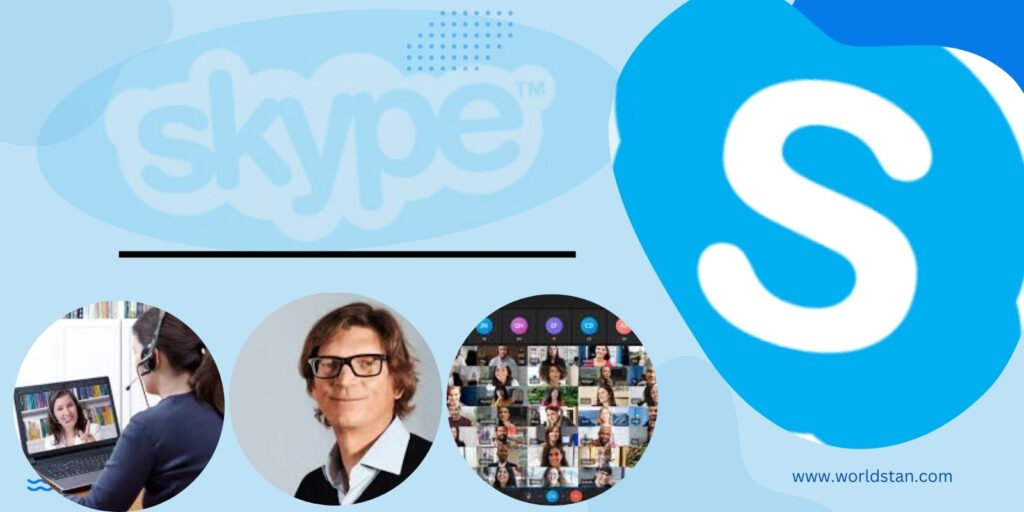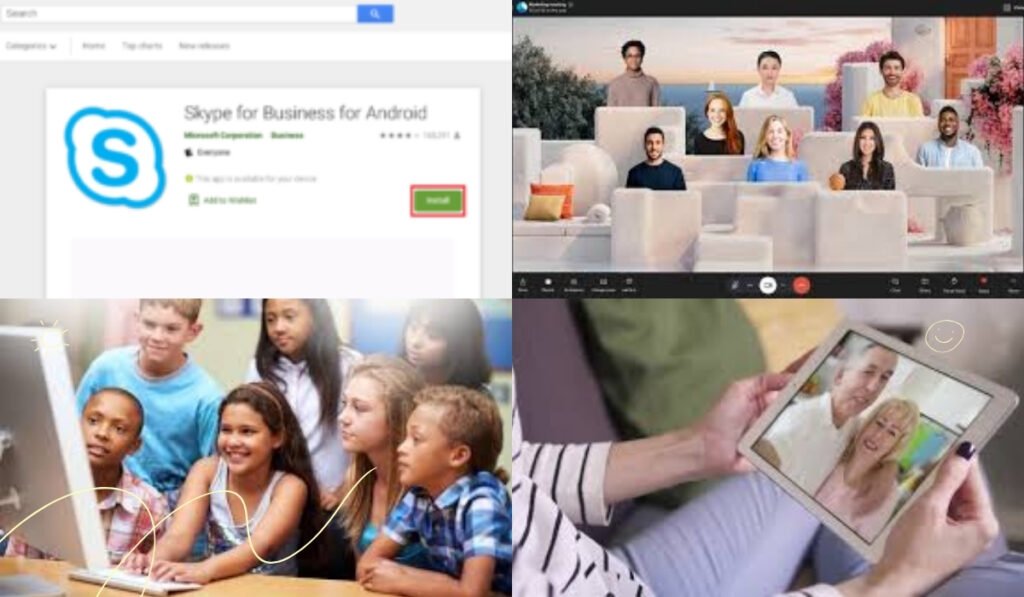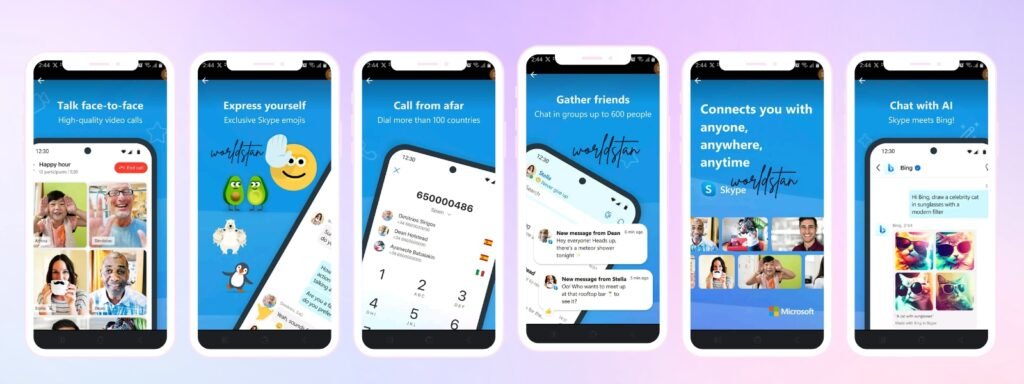
- What revolutionary concept did Skype introduce to internet communication in 2003?
- How did Skype’s peer-to-peer (P2P) network revolutionize scalability?
- What strategic move did eBay make in 2005 regarding Skype?
- How did Microsoft integrate Skype into its ecosystem following its acquisition in 2011?
- What were the key milestones following Microsoft’s acquisition of Skype in 2011?
- What significant advancements followed Microsoft’s acquisition of Skype?
- What privacy concerns were raised regarding Skype’s encryption and surveillance?
- How did Skype address security and privacy concerns over time?
- How does Skype support language diversity among its users?
- What educational initiatives has Skype undertaken, and what challenges has it faced?
- What year did Skype revolutionize internet communication?
- Who were the developers behind Skype’s pioneering software?
- Where was Skype Technologies based?
- What capabilities did Skype integrate into its platform?
- How did Skype leverage the voice-over-Internet protocol (VoIP)?
- What milestone did Skype achieve by 2005 in terms of users?
- What sets Skype’s VoIP system apart from conventional telephone networks?
- Who conceived Skype’s decentralized, peer-to-peer (P2P) network?
- How did Skype’s P2P network revolutionize scalability?
- What philosophy does Skype embrace in terms of services?
- What services does Skype offer free of charge?
- How do users communicate on Skype?
- What supplementary features does Skype offer?
- How did eBay initially get involved with Skype?
- Who acquired Skype in 2011, and for how much?
- How did Microsoft envision integrating Skype into its products?
- What products did Microsoft integrate Skype into?
- What foundation did Skype lay for Facebook?
- What is one word that epitomizes Skype’s journey?
- Who were the key individuals behind Skype’s inception?
- When was Skype’s first public beta release?
- What strategic alliance did Skype establish in 2005?
- Who acquired Skype Technologies SA in September 2005?
- How much did eBay acquire Skype for?
- When was Skype divested in 2009, and to whom?
- What notable collaboration occurred with Comcast in July 2011?
- What feature did Skype introduce in June 2013?
- Which payment service did Skype collaborate with between 2017 and 2020?
- What feature did Skype introduce in collaboration with PayPal?
- How was Skype recognized in 2019 in terms of mobile apps?
- How many mobile apps were downloaded globally in the 2010-2019 decade?
- What category did Skype fall into regarding mobile app downloads?
- How did Microsoft finalize its acquisition of Skype?
- When was the acquisition of Skype completed by Microsoft?
- How did Microsoft integrate Skype into its Windows 8 and Windows RT operating systems?
- When did Microsoft launch a dedicated Skype client app for Windows 8?
- What messaging app did Skype replace on Windows 8.1?
- When did Microsoft discontinue Windows Live Messenger in favor of Skype?
- When did Microsoft announce the replacement of Lync with Skype for Business?
- What was the purpose of transitioning from Lync to Skype for Business?
- What did Microsoft’s integration of Skype signify?
- When did Microsoft unveil HD quality video for Apple iPhone and iPad apps?
- What version update introduced HD quality video for Apple devices?
- What Microsoft product integrated a new chat powered by Skype in November 2014?
- What did the integration of Skype with Microsoft Office enable?
- What did Skype introduce in September 2015 to revolutionize expression?
- What are “Mojis”?
- What is the aim of “Mojis” in Skype conversations?
- When did Skype introduce an early Alpha version of a new Skype for Linux client?
- Which technology was the new Skype for Linux client built with?
- What updates were introduced in September and October 2016 for Skype?
- What did Skype for Business launch for Mac in October 2016?
- When did Microsoft announce plans to discontinue its Skype Wi-Fi service globally?
- When did the Skype Wi-Fi service cease functioning?
- What initiatives aimed to revamp Skype’s functionality?
- What were Microsoft’s plans to incorporate into Skype’s features?
- How did Skype handle encryption and privacy claims?
- What encryption method did Skype initially promote as robust?
- What surveillance program underscored Skype’s vulnerability to clandestine surveillance?
- How did Skype’s incorporation of features raise suspicions?
- What concerns were raised about Skype’s cooperation with law enforcement agencies?
- What legal requirements posed challenges to Skype’s operation?
- What efforts did Microsoft make to address privacy concerns?
- What significant step did Skype take towards bolstering user privacy?
- What signifies Skype’s commitment to privacy protection?
- What languages does Skype offer support for?
- How many languages can users access Skype in?
- What customization options does Skype offer for language support?
- How does Skype ensure inclusivity across diverse language communities?
- What is one prevalent use case of Skype’s non-paid version in education?
- How does Skype enhance learning opportunities?
- What initiative does Skype offer for educators to create interactive classrooms?
- What does the Skype in the Classroom initiative aim to encourage?
- What educational program connects classrooms with volunteer scientists?
- Who established the “Skype a Scientist” program?
- How many classrooms were connected through the “Skype a Scientist” initiative?
- How many volunteer scientists participated in the “Skype a Scientist” program?
- What challenges does Skype face in terms of adoption in educational institutions?
- What restrictions do some educational institutions impose on Skype?
- What reasons are speculated behind the restrictions on Skype in educational institutions?
Table of Contents
ToggleIntroduction to Skype:
In 2003, Skype revolutionized internet communication with its pioneering software, developed by Niklas Zennström and Janus Friis. Operating from Luxembourg, Skype Technologies introduced a dynamic platform integrating voice, video, and instant messaging capabilities, leveraging the voice-over-Internet protocol (VoIP). This groundbreaking approach garnered 50 million users by 2005, skyrocketing to over 600 million within the subsequent half-decade.
Setting itself apart from conventional telephone networks, Skype’s VoIP system converts analog voice signals into digital data transmitted over the internet. The platform’s decentralized, peer-to-peer (P2P) network, conceived by Zennström and Friis, revolutionized scalability by distributing processing tasks and bandwidth among interconnected computers. This innovative model, licensed by eBay from Joltid, propelled exponential growth while minimizing infrastructure overheads.Embracing the philosophy of freeware, Skype offers fundamental services such as in-network calling free of charge. Users seamlessly communicate through voice and video calls using the desktop client or compatible smartphones. Supplementary features like caller identification, voicemail, and conference calling enhance its versatility, with options to expand functionality to traditional telephone networks for a fee.
The trajectory of Skype’s ownership underscores its strategic importance in the digital realm. Acquired by eBay in 2005 for $2.5 billion, Skype encountered challenges integrating within the auction giant’s ecosystem. Subsequent divestment attempts witnessed Zennström and Friis reclaiming stakes amid legal disputes over intellectual property rights. Microsoft’s acquisition of Skype in 2011 for $8.5 billion marked a pivotal moment, affirming its indispensable role in the tech landscape.Microsoft envisioned Skype’s integration beyond conventional boundaries, embedding the platform into diverse products such as Xbox, Outlook, and Windows smartphones. Concurrently, Skype laid the foundation for Facebook’s venture into video chat services, solidifying its position as an indispensable tool for contemporary communication.Skype’s journey epitomizes innovation, resilience, and adaptability, continually redefining the parameters of digital communication in an ever-evolving technological landscape.
The History of Skype:
The Genesis of Skype:
A Collaborative Innovation Journey
Skype’s inception in 2003 by Niklas Zennström of Sweden and Janus Friis of Denmark marks a pivotal moment in internet communication. Spearheaded by Estonian developers Ahti Heinla, Priit Kasesalu, Jaan Tallinn, and Toivo Annus, Skype emerged from the visionary idea of Friis and Annus to revolutionize voice calls using a peer-to-peer (P2P) protocol akin to Kazaa. Initial trials of an alpha version commenced in spring 2003, with the first public beta release on 29 August 2003.
Expanding Horizons:
Strategic Partnerships and Acquisitions
In June 2005, Skype established a strategic alliance with the Polish web portal Onet.pl, paving the way for comprehensive integrated solutions within the Polish market. The momentum continued as eBay Inc. announced its acquisition of Skype Technologies SA in September 2005 for approximately US$2.5 billion. Subsequent divestment in 2009 saw eBay selling 65% of Skype to Silver Lake, Andreessen Horowitz, and the Canada Pension Plan Investment Board for US$1.9 billion. A notable collaboration with Comcast in July 2011 further propelled Skype’s reach, bringing its video chat service to Comcast subscribers via HDTV sets.
Evolution of Features:
Video Messaging and Financial Integration
Skype’s evolution is marked by continuous innovation and feature enhancements. In June 2013, the platform introduced free video messaging services across multiple operating systems, including Windows, Mac OS, iOS, iPadOS, Android, and BlackBerry. Collaborating with PayPal between 2017 and 2020, Skype introduced a money-send feature, allowing users to seamlessly transfer funds within the Skype mobile app during conversations.
Milestones in User Adoption and Recognition
Skype’s impact resonated globally, as evidenced by its recognition as the sixth most-downloaded mobile app of the decade (2010-2019) in 2019. This acknowledgment underscores Skype’s enduring relevance and popularity among users worldwide, solidifying its status as a leading force in digital communication.
Skype’s journey exemplifies collaborative innovation, strategic partnerships, and a commitment to enhancing user experience, positioning it as a trailblazer in the realm of internet communication.
Date | Event |
2003 | Inception of Skype by Niklas Zennström and Janus Friis. |
Development of the software by Ahti Heinla, Priit Kasesalu, Jaan Tallinn, and Toivo Annus. | |
Spring 2003 | Creation and testing of the early alpha version of Skype. |
29 August 2003 | Release of the first public beta version of Skype. |
June 2005 | Collaboration with Onet.pl for integrated solutions in the Polish market. |
12 September | Acquisition agreement by eBay for Skype Technologies SA, valuing at approximately US$2.5 billion. |
2005 | Purchase of Skype by eBay Inc. |
1 September | Sale of 65% stake in Skype by eBay to Silver Lake, Andreessen Horowitz, and Canada Pension Plan Investment Board. |
2009 | Divestment of a portion of Skype by eBay, valued at US$2.75 billion. |
14 July 2011 | Partnership with Comcast to introduce video chat service for Comcast subscribers. |
17 June 2013 | Launch of free video messaging services across various operating systems. |
2013 | Introduction of free video messaging services by Skype. |
2017 – 2020 | Collaboration with PayPal to integrate money transfer feature within the app. |
2019 | Recognition as the sixth most-downloaded mobile app of the decade. |
Microsoft's Integration of Skype:
A New Era of Communication
Acquisition and Incorporation:
On 10 May 2011, Microsoft Corporation finalized the acquisition of Skype Communications, S.à r.l for a staggering US$8.5 billion. With this purchase, Microsoft absorbed all of Skype’s technologies, incorporating it as a division within its operations. The acquisition process concluded on 13 October 2011, signaling a significant shift in the landscape of digital communication.
Seamless Integration with Microsoft Ecosystem:
Microsoft wasted no time in integrating the Skype service with its suite of products. It assumed control over the development of existing Skype desktop and mobile applications while simultaneously crafting a dedicated client app tailored for its touch-centric Windows 8 and Windows RT operating systems. This dedicated app debuted on the Windows Store coinciding with the launch of Windows 8 on 26 October 2012. Subsequently, it became the default messaging application for Windows 8.1, supplanting the existing Windows 8 Messaging app, and was pre-installed on all devices running or upgraded to 8.1.
Streamlining Operations
Transition from Legacy Products:
In a strategic move, Microsoft embarked on a month-long transition from 8 to 30 April 2013, discontinuing two of its own products in favor of Skype. Notably, the widely-used Windows Live Messenger instant messaging service was phased out, except for continued availability in mainland China until October 2014. This streamlined approach consolidated Microsoft’s messaging offerings under the Skype banner, enhancing user experience and operational efficiency.
Evolution into Skype for Business:
Recognizing the need for unified communication solutions, Microsoft announced on 11 November 2014, its plans to replace its Lync product with Skype for Business in 2015. This transition aimed to amalgamate the functionalities of Lync with the consumer-oriented features of Skype, empowering organizations to seamlessly switch between the default Skype for Business interface and the familiar Lync interface based on their specific requirements.
Microsoft’s integration of Skype signifies a strategic alignment with its broader ecosystem, ushering in a new era of interconnected communication solutions tailored to meet evolving user needs and industry demands.
Date | Event |
10 May 2011 | Microsoft acquires Skype Communications, S.à r.l for US$8.5 billion. |
13 October 2011 | Completion of Microsoft’s acquisition of Skype, incorporating it as a division within the company. |
26 October 2012 | Introduction of a dedicated Skype client app for Windows 8 and Windows RT operating systems. |
Skype becomes default messaging app for Windows 8.1, pre-installed on devices upgraded to 8.1. | |
8 – 30 April 2013 | Microsoft discontinues Windows Live Messenger in favor of Skype, except in mainland China until October 2014. |
11 November 2014 | Microsoft announces the replacement of Lync with Skype for Business, integrating functionalities of both platforms. |
Advancements Following Acquisition:
In the aftermath of Microsoft’s acquisition of Skype, a series of transformative developments reshaped the landscape of digital communication.
Enabling High-Quality Video:
In August 2013, Skype unveiled the 4.10 update for Apple iPhone and iPad apps, heralding the era of HD quality video for iPhone 5 and fourth-generation iPads.
Integration with Microsoft Office:
November 2014 witnessed a significant milestone as Microsoft Office integrated a new chat powered by Skype. This integration enabled seamless intra-document communication, empowering users to interact with co-workers within the same document.
Introduction of Mojis:
Skype revolutionized expression in September 2015 with the introduction of Mojis. These short video clips and GIFs, featuring iconic characters from films and TV shows, offered users a novel way to convey emotions during conversations. Collaborations with major studios enhanced the Mojis collection, enriching the user experience.
Expansion to New Platforms:
In response to user demand, Skype expanded its horizons. July 2016 saw the introduction of an early Alpha version of a new Skype for Linux client, built with WebRTC technology. Subsequent updates in September and October of the same year brought new features to the iOS app and launched Skype for Business for Mac, respectively.
Streamlining Services:
In February 2017, Microsoft announced plans to discontinue its Skype Wi-Fi service globally, marking a strategic shift. The application ceased functioning on 31 March 2017. Subsequent initiatives aimed to revamp Skype’s functionality, including plans to incorporate features reminiscent of Snapchat.
Interface Overhaul:
Microsoft’s transition of Skype from a peer-to-peer to a central server-based system was accompanied by significant interface overhauls. Windows, iOS, Android, Mac, and Linux platforms all underwent visual enhancements, with a focus on prioritizing text-based messaging over voice calling.
Date | Event |
12 August 2013 | Skype releases 4.10 update for Apple iPhone and iPad apps, enabling HD quality video for iPhone 5 and fourth-generation iPads. |
20 November 2014 | Microsoft Office integrates new chat powered by Skype, facilitating intra-document communication among users. |
15 September 2015 | Skype introduces Mojis, featuring short video clips and GIFs from films and TV shows, enhancing expressive communication on the platform. |
Microsoft acquires technology from Talko, enriching Skype’s capabilities. | |
July 2016 | Skype launches early Alpha version of new Skype for Linux client using WebRTC technology. |
September 2016 | iOS app updated with new features, including Siri voice command integration. |
October 2016 | Microsoft debuts Skype for Business for Mac. |
February 2017 | Microsoft announces discontinuation of Skype Wi-Fi service globally. |
June 2017 | Plans unveiled to revamp Skype with Snapchat-like features for temporary photo and video sharing. |
Late June 2017 | iOS app receives update with revamped design and third-party integrations. |
December 2017 | Introduction of “Skype Interviews,” facilitating shared code editing for programming job interviews. |
Microsoft transitions Skype from peer-to-peer to central server system, enhancing text-based messaging features and updating user interfaces across platforms. |
Security and Privacy Concerns:
Encryption and Privacy Claims:
Skype’s early assertions of being a secure communication platform boasted of “highly secure with end-to-end encryption.” The encryption, based on RSA for key negotiation and the Advanced Encryption Standard for conversation encryption, was promoted as robust. However, the lack of transparency and the proprietary nature of Skype’s protocols raised concerns about verifiability and user privacy.
Surveillance and Privacy Breaches:
The revelation of the PRISM surveillance program underscored the vulnerability of Skype’s data to clandestine surveillance by agencies like the NSA. Skype’s incorporation of features that obscure its traffic raised suspicions, but it was not specifically designed for anonymous communication. Reports suggested that Skype might have provided authorities access to user information, leading to concerns about privacy breaches and surveillance.
Legal and Technical Challenges:
Legal requirements, such as the Communications Assistance for Law Enforcement Act (CALEA), posed challenges to Skype’s operation. The interpretation of such laws by regulatory bodies like the FCC raised questions about compliance and user privacy. Microsoft’s alleged efforts to facilitate wiretapping and its cooperation with law enforcement agencies further fueled apprehensions about privacy infringement.
Vulnerabilities and Security Flaws:
Skype’s history was marred by security vulnerabilities and flaws. From IP address tracking to account takeovers and data breaches, users faced persistent risks. Automatic updates aimed at enhancing security faced resistance from users concerned about loss of control over updates.
End-to-End Encryption:
Despite past shortcomings, Skype has made strides in addressing privacy concerns. The implementation of end-to-end encryption across all platforms signifies a significant step towards bolstering user privacy and data security. However, ongoing vigilance and scrutiny are imperative to ensure sustained commitment to privacy protection.
Language Support in Skype:
Built-In Locales and Languages:
Skype offers comprehensive language support, catering to diverse linguistic preferences worldwide. Users can access Skype in a multitude of languages, including Arabic, Bulgarian, Catalan, Chinese (both Traditional and Simplified), Croatian, Czech, Danish, Dutch, English, Estonian, Finnish, French, German, Greek, Hebrew, Hungarian, Indonesian, Italian, Japanese, Korean, Latvian, Lithuanian, Nepali, Norwegian, Polish, Portuguese (both Brazilian and European), Romanian, Russian, Serbian, Slovak, Slovenian, Spanish, Swedish, Thai, Turkish, Ukrainian, and Vietnamese.
Customization Options:
The Windows desktop version of Skype goes beyond built-in language options, empowering users to create and utilize new language files. This flexibility allows for the incorporation of additional languages and localized content, enabling users to tailor their Skype experience to their specific linguistic needs. As a result, users can access Skype in over 80 additional (full or partial) localizations, ensuring inclusivity and accessibility across diverse language communities.

Skype's Educational Potential Application:
Educational Application:
Despite being primarily a commercial platform, Skype’s non-paid version is increasingly utilized by educators, schools, and charitable organizations for various global education initiatives. One prevalent use case involves facilitating language learning through conversational exchanges in participants’ native languages.
Enhanced Learning Opportunities through Video Conferencing:
Skype’s video conferencing feature has garnered praise for its capacity to connect students speaking different languages, enable virtual field trips, and facilitate direct engagement with subject matter experts. This functionality enriches the learning experience by transcending geographical boundaries and fostering interactive learning environments.
Skype in the Classroom Initiative:
Skype in the Classroom represents a complimentary tool provided by Skype on its platform, aimed at encouraging educators to create more interactive classrooms and collaborate with peers worldwide. The initiative offers various Skype lessons for student participation and empowers teachers to leverage a search tool to connect with experts in specific fields.
Impactful Educational Programs like Skype a Scientist:
Skype’s educational endeavors extend to initiatives like Skype a Scientist, established by biologist Sarah McAnulty in 2017. Over two years, this program successfully facilitated connections between 14,312 classrooms and over 7,000 volunteer scientists, offering students firsthand insights into various scientific disciplines.
Adoption Challenges and Network Restrictions:
Despite its educational benefits, Skype faces uneven adoption rates, with numerous educational institutions in the United States and Europe choosing to block the application from their networks. The reasons behind these restrictions remain unspecified, highlighting potential concerns or policy considerations within these institutions.
Account Management and Customer Support:
Policy Enhancements for User Accounts:
In January 2010, Skype instituted substantial revisions to its policies concerning inactive accounts, discontinuing the practice of seizing funds from accounts without paid calls for 180 days. This change was precipitated by the resolution of a class-action lawsuit, underscoring Skype’s commitment to enhancing customer satisfaction. Moreover, as part of the settlement, Skype extended compensation of up to US$4 to individuals engaged in the legal proceedings.
Expansion of Customer Support Infrastructure:
By February 2012, Skype had expanded its support framework to ensure users receive prompt assistance as needed. Users now benefit from access to a diverse array of support avenues, including the web support portal, community forums, @skypesupport on Twitter, and the official Skype Facebook page. Direct contact options, such as email and live chat, are available via the web support portal, while Chat Support is presented as a premium feature to select paid users.
Refund Policy Transparency and Fairness:
Skype’s refund policy aims to instill peace of mind among users by offering full refunds for unused Skype Credit balances below 1 euro. Furthermore, upon request, Skype extends pro-rated refunds for the unused period of a product, emphasizing equity and transparency in financial transactions.
Addressing User Concerns and Feedback:
Despite earnest efforts to enhance user experience, Skype has encountered criticism regarding its procedures for account closure. Some users have voiced frustration over the inability to fully terminate their accounts, with the sole recourse being to deactivate the account by expunging personal information, except for the username. This feedback underscores the necessity for refined account management options to grant users enhanced control.
Compensation for Service Disruptions:
In instances of service disruptions, such as the outage on 21 September 2015 affecting users in New Zealand, Australia, and other regions, Skype has demonstrated its dedication to customer satisfaction by extending compensation. Affected users were furnished with 20 minutes of complimentary calls to over 60 landline and 8 mobile phone destinations as a gesture of goodwill and recognition of the inconvenience incurred.
Date | Event |
January 2010 | Skype revises its inactive account policy after settling a class-action lawsuit, discontinuing the seizure of funds. |
February 2012 | Enhanced customer support options introduced, including web portal, community forums, Twitter, and Facebook. |
Chat Support becomes a premium feature for select paid users. | |
Refund Policy | Skype offers full refunds for unused Skype Credit under 1 euro, with prorated refunds for unused product periods. |
Account Closure | Users criticize Skype for the inability to fully close accounts, with only the option to make them inactive. |
September 2015 | Skype compensates users affected by a service outage with 20 minutes of free calls to select destinations. |
Conclusion:
Skype’s inception in 2003 marked a watershed moment in the evolution of internet communication. Developed by visionaries Niklas Zennström and Janus Friis, alongside a team of talented developers, Skype Technologies introduced a dynamic platform that seamlessly integrated voice, video, and instant messaging capabilities. Leveraging the VoIP protocol, Skype transcended traditional telephone networks, converting analog voice signals into digital data transmitted over the internet. This innovative approach, underpinned by a decentralized, peer-to-peer network, revolutionized scalability while minimizing infrastructure overheads, propelling Skype’s rapid ascent to over 600 million users within a decade.
The trajectory of Skype’s ownership, from its acquisition by eBay in 2005 to subsequent divestments and Microsoft’s landmark acquisition in 2011, underscored its strategic significance in the digital landscape. Challenges integrating within eBay’s ecosystem prompted divestment attempts, culminating in Microsoft’s acquisition for $8.5 billion. Microsoft’s vision extended beyond conventional boundaries, embedding Skype into diverse products like Xbox and Outlook, while laying the foundation for Facebook’s venture into video chat services. This strategic integration solidified Skype’s position as an indispensable tool for contemporary communication, epitomizing innovation, resilience, and adaptability in a rapidly evolving technological landscape.
Skype’s collaborative innovation journey, spearheaded by a diverse team of developers from Estonia to Sweden and Denmark, exemplifies the power of visionary ideas and strategic partnerships. From its strategic alliance with Onet.pl to collaborations with Comcast, Skype’s expansion into global markets and integration into diverse platforms propelled its reach and impact. As Skype continues to redefine the parameters of digital communication, its legacy serves as a testament to the transformative potential of collaborative innovation in shaping the future of connectivity and communication.
FAQs:
- What revolutionary concept did Skype introduce to internet communication in 2003?
Skype introduced a dynamic platform integrating voice, video, and instant messaging capabilities using the voice-over-Internet protocol (VoIP), revolutionizing internet communication.
- How did Skype’s peer-to-peer (P2P) network revolutionize scalability?
Skype’s P2P network distributed processing tasks and bandwidth among interconnected computers, minimizing infrastructure overheads and enabling exponential growth.
- What strategic move did eBay make in 2005 regarding Skype?
In 2005, eBay acquired Skype Technologies SA for approximately US$2.5 billion, recognizing its strategic importance in the digital realm.
- How did Microsoft integrate Skype into its ecosystem following its acquisition in 2011?
Microsoft embedded Skype into diverse products such as Xbox, Outlook, and Windows smartphones, expanding its integration beyond conventional boundaries.
- What were the key milestones following Microsoft’s acquisition of Skype in 2011?
Key milestones include the introduction of a dedicated Skype client app for Windows 8, discontinuation of Windows Live Messenger in favor of Skype, and the announcement of Skype for Business to replace Lync.
- What significant advancements followed Microsoft’s acquisition of Skype?
Advancements included the introduction of HD quality video for Apple devices, integration with Microsoft Office, introduction of Mojis for expression, and expansion to new platforms like Linux and Mac.
- What privacy concerns were raised regarding Skype’s encryption and surveillance?
Concerns were raised regarding the lack of transparency and proprietary nature of Skype’s protocols, its vulnerability to surveillance programs like PRISM, and potential privacy breaches due to cooperation with law enforcement agencies.
- How did Skype address security and privacy concerns over time?
Skype implemented end-to-end encryption across all platforms to bolster user privacy and data security, representing a significant step towards addressing past shortcomings.
- How does Skype support language diversity among its users?
Skype offers comprehensive language support with built-in locales and languages in over 80 additional localizations, empowering users to access the platform in their preferred language.
- What educational initiatives has Skype undertaken, and what challenges has it faced?
Skype has initiatives like Skype in the Classroom and Skype a Scientist to enhance learning opportunities, despite facing challenges such as uneven adoption rates and network restrictions in educational institutions.


Prof. Mian Waqar Ahmad
Prof. Mian Waqar Ahmad, a dynamic force straddling the realms of academia and digital media. As a distinguished Lecturer in Information Sciences, he imparts knowledge within the academic sphere, igniting the minds of his students. Beyond the classroom, Prof. Mian Waqar Ahmad dons the hat of a seasoned blogger on Worldstan.com, where his insightful posts delve into the intricacies of information sciences. His digital footprint extends even further as a YouTuber, leveraging the platform to share his expertise and make complex concepts accessible to a global audience. Prof. Mian Waqar Ahmad’s journey embodies the fusion of traditional education and contemporary digital outreach, leaving an indelible mark on the evolving landscape of information sciences. Explore his world at Worldstan.com and witness the convergence of academia and the digital frontier.
